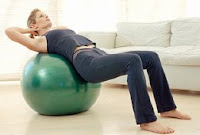J Occup Rehabil. 2009 May 7; Duque IL, Parra JH, Duvallet AIntroduction The measurement of the maximal oxygen uptake as a parameter of cardiorespiratory fitness is useful in exercise prescription in functional restoration programs but this measurement requires the subject's maximal exertion which is not always possible in patients with chronic low back pain. The purpose of this study was to develop a regression equation to predict maximal oxygen uptake based on non-exercise data in adult patients with chronic low back pain. Methods Cross sectional study in which 70 participants completed a maximal graded exercise test in cycle ergometer to assess maximal oxygen uptake. Results Patients achieved a mean +/- SD value of VO(2)max of 30.8 (+/-7.7) ml kg(-1) min(-1). The regression model included as data of non-exercise the patient's gender, body mass index and the intensity of physical activity during leisure time. Multiple linear regression analysis generated the following formula (R (2) = 38.3, SEE = 6.08 ml kg(-1) min(-1)): VO(2)max (ml kg(-1) min(-1)) = 35.3377 - 0.475411 x BMI + 0.155232 x PALT + 7.97682 x gender; where BMI = body mass index, PALT = physical activity during leisure time, women = 0, men = 1. The Durbin Watson statistic showed no problems with serial autocorrelation (D -W = 1.86). The Kolmogorov-Smirnov normality test demonstrated that the errors are distributed normally. Conclusions This study provides a new and relatively precise non-exercise regression model to predict VO(2)max in patients with chronic low back pain.



